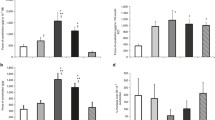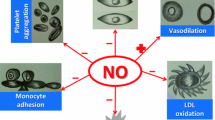Abstract
Objective
This study investigated the response of the human umbilical artery to various agonists in order to determine which agents might be involved in umbilical cord closure.
Methods
Umbilical artery rings from 22 cesarean deliveries were suspended in tissue baths containing Krebs-Henseleit solution under low and normal oxygen conditions. Samples were challenged with 5-hy-droxytryptamine, acetylcholine, angiotensin II, bradykinin, endothelin-1, histamine, norepinephrine, phenylephrine, and U46619 (a thromboxane A2 mimetic).
Results
Only 5-hydroxytryptamine, bradykinin, endothelin-1, histamine, and V46619 produced appreciable maximal contractions. Furthermore, although the contractile force generated by these agonists was diminished in normal oxygen conditions, this reduction affected responses to 5-hydroxytryptamine and U46619 least.
Conclusion
5-Hydroxytryptamine and U46619 demonstrated the characteristics most likely to be associated with closure of the umbilical artery, ie, they elicited strong, sustained contractions at physiologic concentrations and under both normal and low-oxygen conditions. These data suggest that closure of the umbilical artery may be mediated by 5-hydroxytryptamine and thromboxane A2.
Similar content being viewed by others
References
Rockelein G, Scharl A. Scanning microscopic investigations of the human umbilical artery intima. Virchows Archiv A Pathol Anat 1988;413:555–61.
McGrath JC, MacLennan SJ, Man AC, Stuart-Smith K, Whittle MJ. Contraction of human umbilical artery, but not vein, by oxygen. J Physiol 1986;380:513–9.
MacLennan SJ, McGrath JC, Whittle MJ. Inhibition of the oxygen-induced contraction of the isolated human umbilical artery by indomethacin, flurbiprofen, aspirin and drugs modifying Ca2+ disposition. Prostaglandins 1988;36:711–29.
White RP. Pharmacodynamic study of maturation and closure of human umbilical arteries. Am J Obstet Gynecol 1989;160:229–37.
McCallum WD, McAreavey DRM. Human umbilical vessel diameters and blood gas tensions in the first two minutes after delivery. Gynecol Invest 1976;7:201–5.
Fox SB, Khong TY. Lack of innervation of human umbilical cord. An immunohistological and histochemical study. Placenta 1990;11:59–62.
Altura BM, Malaviya D, Reich CF, Orkin LR. Effects of vasoactive agents on isolated human umbilical arteries and veins. Am J Physiol 1972;222:345–55.
Hemsen A, Gillis C, Larsson O, Haegerstrand A, Lundberg JM. Characterization, localization, and actions of endothelins in umbilical vessels and placenta of man. Acta Physiol Scand 1991;143:395–404.
Izumi H, Garfield RE, Makino Y, Koichi S, Itoh T. Gestational changes in endothelium-dependent vasorelaxation in human umbilical artery. Am J Obstet Gynecol 1994;170:236–45.
Tuvemo TM. The actions of prostaglandins and cyclo-oxygenase inhibition on the resistance vessels supplying the human fetal placenta. Prostaglandins 1981;21:1033–43.
Yao AC, Lind J, Lu T. Closure of the human umbilical artery: A physiological demonstration of Burton’s theory. Eur J Obstet Gynecol Reprod Biol 1977;7:365–8.
Eltherington LG, Stoff J, Hughes T, Melmon KL. Constriction of human umbilical arteries: Interaction between oxygen and bradykinin. Circ Res 1968;22:747–52.
Mitchell RG, Porter JF. Histamine and granulocytes in the umbilical cord blood of infants at birth. Br J Pharmacol 1970;40:310–6.
Nisell H, Hemsen A, Lunell NO, Wolff K, Lundberg MJ. Maternal and fetal levels of a novel polypeptide, endothelin: Evidence for release during pregnancy and delivery. Gynecol Obstet Invest 1990;30:129–32.
Mitchell MD, Bibby JG, Hicks BR, Redman CW, Anderson AB, Turnbull AC. Thromboxane B2 and human parturition: Concentrations in the plasma and production in-vitro. J Endo crinol 1978;78:435–41.
Stacey RS. Clinical aspects of cerebral and extracerebral 5-hy-droxytryptamine. In: Erspamer V, ed. Handbook of experimental pharmacology, Vol. 19. Berlin: Springer-Verlag, 1966:744–86.
McGrath JC, MacLennan SJ, Whittle MJ. Comparison of the effects of oxygen, 5-hydroxytryptamine, bradykinin and adrenaline in isolated human umbilical artery smooth muscle. Q J Expl Physiol 1988;73:547–59.
Bodelsson G, Laursen M, Stjernquist M. Oxygen promotes contraction by endothelin-1 in human umbilical artery. Hum Reprod 1996;11:2767–8.
Mitchell MD, Brunt J, Bibby J, Flint AP, Anderson AB, Turnbull AC. Prostaglandins in the human umbilical circulation at birth. Br J Obstet Gynaecol 1978;85:114–8.
Kennedy I, Coleman RA, Humphrey PPA, Levy GP, Lumley P. Studies on the characterisation of prostanoid receptors: A proposed classification. Prostaglandins 1982;24:667–89.
Serneri NGG, Abbate R, Gensini GF, Panetta A, Casolo GC, Carini M. TxA2 production by human arteries and veins. Prostaglandins 1983;25:753–66.
Templeton AGB, McGrath JC, Whittle MJ. The role of endogenous thromboxane in contractions to U46619, oxygen, 5-HT and 5-CT in the human isolated umbilical artery. Br J Pharmacol 1991;103:1079–84.
Mijovic JE, Zakar T, Nairn TK, Olson DM. Prostaglandin endoperoxide H synthase (PGHS) activity and PGHS-1 and -2 messenger ribonucleic acid abundance in human chorion throughout gestation and with preterm labor. J Clin Endocrinol Metab 1998;83:1358–67.
Ylikorkala O, Makarainen L, Viinikka L. Prostacyclin production increases during human parturition. Br J Obstet Gynaecol 1981;88:513–6.
Bjoro K, Hovig T, Stokke KT, Stray-Pederson S. Formation of prostanoids in human umbilical vessels perfused in vitro. Prostaglandins 1986;31:683–97.
Okatani Y, Taniguchi K, Sagara Y. Amplifying effect of endothelin-1 on serotonin-induced vasoconstriction of human umbilical artery. Am J Obstet Gynecol 1995;172:1240–5.
Trundinger BJ, Giles W, Cook CM. Flow velocity waveforms in the maternal uteroplacental and fetal umbilical placental circulations. Am J Obstet Gynecol 1985;152:155–63.
Mäkilä U-M, Jouppila P, Kirkinen P, Viinikka L, Ylikorkala O. Relation between umbilical prostacyclin production and blood-flow in the fetus. Lancet 1983;1:728–9.
Giles WB, Trudinger BJ, Baird PJ. Fetal umbilical artery flow velocity waveforms and placental resistance: Pathological correlation. Br J Obstet Gynaecol 1985;92:31–8.
Clapp JF, Szeto HH, Larrow R, Hewitt J, Mann LI. Umbilical blood flow response to embolization of the uterine circulation. Am J Obstet Gynecol 1980;138:60–7.
Author information
Authors and Affiliations
Corresponding author
Additional information
This work was supported in part by a University of Hong Kong Block Grant and a Committee on Research and Conference (CRCG) grant. S.W.S.L was the recipient of a University of Hong Kong Studentship and a Postgraduate Student Fellowship from the Sir Edward Youde Memorial Fund.
We gratefully acknowledge the help of Ms. Teresa Cheung in gathering patient data and the operating theatre staff at Tsan Yuk Hospital, we would like to thank Mr. Norman Lee for his assistance in providing the necessary buffer measurements. From The University of Hong Kong, we express our appreciation for the support and input of Dr. Hwee Teoh as well as Mr. Godfrey Man for his indispensable assistance.
Rights and permissions
About this article
Cite this article
Quan, A., Leung, S.W.S., Lao, T.T. et al. 5-Hydroxytryptamine and Thromboxane A2 as Physiologic Mediators of Human Umbilical Artery Closure. Reprod. Sci. 10, 490–495 (2003). https://doi.org/10.1016/S1071-55760300149-7
Published:
Issue Date:
DOI: https://doi.org/10.1016/S1071-55760300149-7




